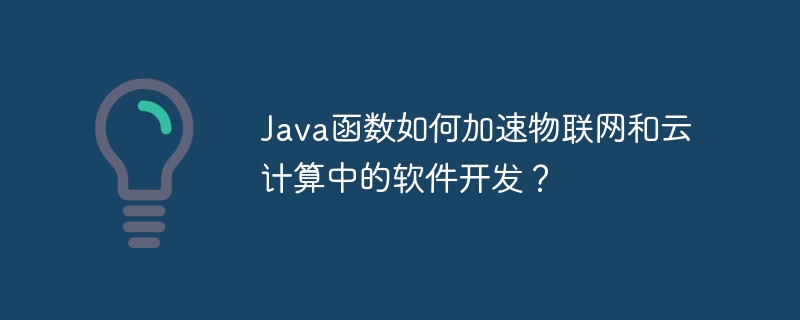 Java
Java
 javaTutorial
javaTutorial
 How can Java functions speed up software development in IoT and cloud computing?
How can Java functions speed up software development in IoT and cloud computing?
How can Java functions speed up software development in IoT and cloud computing?
Java functions are an effective solution for accelerating software development in IoT and cloud computing. Benefits include: Maintenance-free: No servers or infrastructure to manage. Scale on demand: Automatically scale up or down to meet load. Cost-Effectiveness: Only pay for what you use. Language-independent: Works with any programming language, including Java. Practical use cases include IoT sensor data analysis, where Java functions are used to process and analyze data collected from sensors. Functions can be easily integrated with cloud platforms such as Google Cloud Functions and can be managed via Maven jar deployment and gcloud commands.

Use Java functions to accelerate software development in IoT and cloud computing
In the Internet of Things (IoT) and cloud computing In a fast-moving world, speed in software development is critical. Java Functions, a serverless computing paradigm, provide a lightweight and efficient way to accelerate software development.
Advantages of Java functions
Java functions have the following advantages that make them suitable for IoT and cloud computing:
- Maintenance-free: No need to manage servers or infrastructure.
- Scale on demand: Automatically scale up or down to meet load.
- Cost-Effectiveness: Pay only for the resources you use.
- Language agnostic: Can be used with any programming language, including Java.
Practical Case: IoT Sensor Data Analysis
Consider an IoT scenario where sensors collect data and send it to the cloud for analysis. Handlers can be created using Java functions to analyze data, for example:
import com.google.cloud.functions.BackgroundFunction;
import com.google.cloud.functions.Context;
public class SensorDataFunction implements BackgroundFunction<SensorData> {
public void accept(SensorData data, Context context) {
// 分析数据并采取必要的措施,例如发送警报
// ...
}
}Integrate into cloud.google.com
Java functions can be easily integrated with cloud platforms. For example, it can be deployed to Google Cloud Functions by following these steps:
- Use Maven to create a jar containing the function code.
- Use the
gcloudcommand to upload the jar to Google Cloud. - Use the
gcloudcommand to deploy the function.
Conclusion
Java functions provide a powerful solution for software development in IoT and cloud computing. Its serverless architecture, language agnosticity, and cost-effectiveness make it ideal for accelerating development and reducing maintenance overhead.
The above is the detailed content of How can Java functions speed up software development in IoT and cloud computing?. For more information, please follow other related articles on the PHP Chinese website!

Hot AI Tools

Undresser.AI Undress
AI-powered app for creating realistic nude photos

AI Clothes Remover
Online AI tool for removing clothes from photos.

Undress AI Tool
Undress images for free

Clothoff.io
AI clothes remover

AI Hentai Generator
Generate AI Hentai for free.

Hot Article

Hot Tools

Notepad++7.3.1
Easy-to-use and free code editor

SublimeText3 Chinese version
Chinese version, very easy to use

Zend Studio 13.0.1
Powerful PHP integrated development environment

Dreamweaver CS6
Visual web development tools

SublimeText3 Mac version
God-level code editing software (SublimeText3)

Hot Topics
 Square Root in Java
Aug 30, 2024 pm 04:26 PM
Square Root in Java
Aug 30, 2024 pm 04:26 PM
Guide to Square Root in Java. Here we discuss how Square Root works in Java with example and its code implementation respectively.
 Perfect Number in Java
Aug 30, 2024 pm 04:28 PM
Perfect Number in Java
Aug 30, 2024 pm 04:28 PM
Guide to Perfect Number in Java. Here we discuss the Definition, How to check Perfect number in Java?, examples with code implementation.
 Random Number Generator in Java
Aug 30, 2024 pm 04:27 PM
Random Number Generator in Java
Aug 30, 2024 pm 04:27 PM
Guide to Random Number Generator in Java. Here we discuss Functions in Java with examples and two different Generators with ther examples.
 Weka in Java
Aug 30, 2024 pm 04:28 PM
Weka in Java
Aug 30, 2024 pm 04:28 PM
Guide to Weka in Java. Here we discuss the Introduction, how to use weka java, the type of platform, and advantages with examples.
 Armstrong Number in Java
Aug 30, 2024 pm 04:26 PM
Armstrong Number in Java
Aug 30, 2024 pm 04:26 PM
Guide to the Armstrong Number in Java. Here we discuss an introduction to Armstrong's number in java along with some of the code.
 Smith Number in Java
Aug 30, 2024 pm 04:28 PM
Smith Number in Java
Aug 30, 2024 pm 04:28 PM
Guide to Smith Number in Java. Here we discuss the Definition, How to check smith number in Java? example with code implementation.
 Java Spring Interview Questions
Aug 30, 2024 pm 04:29 PM
Java Spring Interview Questions
Aug 30, 2024 pm 04:29 PM
In this article, we have kept the most asked Java Spring Interview Questions with their detailed answers. So that you can crack the interview.
 Break or return from Java 8 stream forEach?
Feb 07, 2025 pm 12:09 PM
Break or return from Java 8 stream forEach?
Feb 07, 2025 pm 12:09 PM
Java 8 introduces the Stream API, providing a powerful and expressive way to process data collections. However, a common question when using Stream is: How to break or return from a forEach operation? Traditional loops allow for early interruption or return, but Stream's forEach method does not directly support this method. This article will explain the reasons and explore alternative methods for implementing premature termination in Stream processing systems. Further reading: Java Stream API improvements Understand Stream forEach The forEach method is a terminal operation that performs one operation on each element in the Stream. Its design intention is





